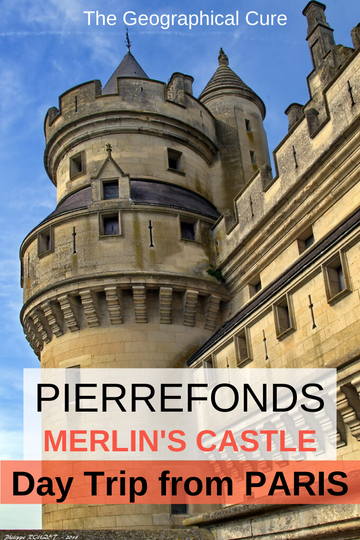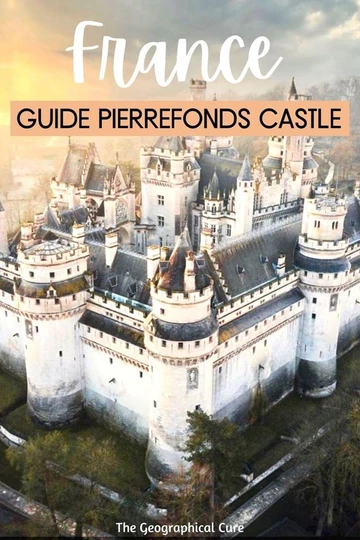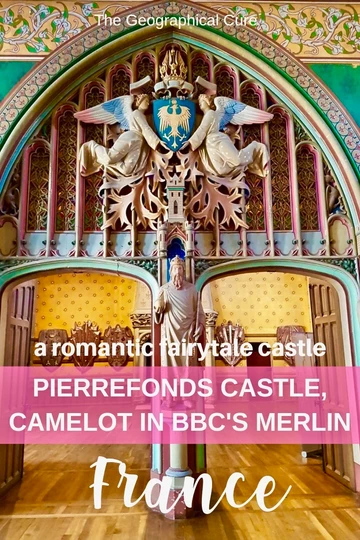Her’s my guide to visiting Pierrefonds Castle, a must see landmark in northern France. Pierrefonds is an easy day trip from Paris.
My travel companion was a castle snob. He didn’t want to stop at Pierrefonds Castle on our sojourn in northern France. “It’s a fake,” he moaned. “It’s an idealized version of a medieval castle, not a real medieval castle,” he intoned.
And all that’s true, yet it didn’t dissuade me one bit. The fairytale castle looked so romantic online with its towers, turrets, and fantastical sculptures. I fell in love with its handsome face at once.
Besides, I loved Viollet-le-Duc’s other Gothic revival confections, Carcassone, in southern France and Notre Dame in Paris. And Pierrefonds is so magical that it even starred as Camelot in the BBC’s hit show Merlin.
I wanted to see Pierrefonds in real life on my geographical cure. I cajoled my friend into a pit stop, thankfully without even having to kneecap him. And I’m glad I was insistent. Pierrefonds is charming and delightful in a way few things are. Even if its restored bits are of slightly more recent vintage.
History of Pierrefonds Castle
In the late 14th century, Louis of Valois, the Duke of Orleans built the fortress of Pierrefonds. Located about an hour north of Paris, it was a defensive fortification intended to solidify Valois power during the French noblemen’s fierce infighting during the Hundred Years War.
In 1413, with Louis’ son Charles now in possession of the castle, Pierrefonds was burned down by a rival Burgundian. Charles gave the order for Pierrefonds to be rebuilt. Upon Charles’ death, the castle passed into the hands of Louis XII.
In 1617, the castle was besieged by an angry Cardinal Richelieu. He and Louis XIII had tired of aristocratic infighting and fiefdoms like Pierrefonds. They wanted a centralized monarchy and to hell with outlying castles.
Richelieu sent an army to demolish Pierrefonds, which was rather difficult given its size. But he managed to smash it up and leave Pierrefonds in quasi ruins. And there it stood, largely ignored for two centuries.
And there I stood, pointing out to my friend that Pierrefonds wasn’t entirely fake. Its bones date from the 14th century.
The 19th century saw the rise of the Romantic Period. Ruins were embraced and rhapsodized as picturesque, poetic elements in the landscape. The ruined Pierrefonds became a pilgrimage site for those with ruin lust and archaeologists. The village of Pierrefonds became a fashionable holiday resort.
In 1832, Pierrefonds was the site of a swishy party celebrating the marriage of Louis-Philippe’s daughter. Pierrefonds was designated a national monument in 1848.
Napoleon III Rebuilds Pierrefonds
Then along came Napoleon. This time it was Louis-Napoléon Bonaparte. In 1848, Louis-Napoleon became the first elected president in France. When his term expired, he didn’t take it well. A coup d’etat later, he pronounced himself emperor of France and retitled himself Napoleon III.
Napoleon III was an ambitious builder. You may recall that he spiffied up Paris with the help of Baron Haussman. In 1857, he turned his sights on Pierrefonds. And hired the famed architect Viollet-le-Duc.
At first, Napoleon III just wanted the habitable portions of the ruined castle restored, namely the keep. But in 1861, the project expanded. Napoleon III longed for a lavish castle, fit for a king and evoking a medieval fantasy.
Romantic Enterprise: Pierrefonds Resurrected
Viollet-le-Duc’s views on restoration offended my friend Jim. Le Duc opined that restoring a monument means “returning it to a state of completion which may never have existed at any point in time.”
So Pierrefeonds is not a faithful reconstruction of a medieval castle. It’s Viollet-le-Duc’s remarkably inventive free interpretation, with ornamental and architectural references from the middle ages and new construction materials.
I wasn’t in the least bothered by that philosophy in this particular instance. Although I might well be in other instances.
Le Duc seems fairly genius in terms of combining history and modernity. Why wouldn’t an architect use steel girders in a restoration project? Or paint rooms in a ruin that, in fact, were previously painted?
Aside from that logic, I loved the lush polychrome color in the painted rooms. Viollet-le-Duc could decorate, maybe not as well Marie Antoinette, but pretty damn well.
And the creative architect made it easier for me to relive history at Pierrefonds. Sadly, much of the furniture he designed for the castle was never made after his death, due to the War of 1870 and the collapse of the Second Empire.
What To See At Pierrefonds Castle
With 8 towers in view, you cross the drawbridge beneath a statue of St. George slaying a dragon, one of the most persistent medieval symbols. There’s also a whimsical salamander drain to admire on your way in.
Then, you’re in the main courtyard. It catches the eye. And the rest of you too.
1. The Keep & the Imperial Apartments
Pierrefonds is unique in having a keep. Inspired by Coucy Castle, one of my favorite French ruins, Viollet-le-Duc wanted to maintain an equilibrium between fortified palace and residence. By placing the imperial apartments in the keep, Viollet-le-Duc simply adapted a medieval tradition.
2. The State Room
The State Room was the massive hallway where Napoleon III would receive guests. The wood carvings and murals feature fantasy beasties, including an elephant headed cricket, a griffin with a woman’s face, and the recurrent Pierrefonds theme of an imperial eagle with wings spread.
Here, and throughout the castle, there are ornamental motifs inspired by nature.
3. The Royal Bedrooms
In Napoleon III’s bedroom, the centerpiece is the fireplace. There’s a pink and gold frieze of imperial bees on its lintel. And there are beautiful decorative elements. The painted frieze running along the top of the wall, in cream and light blue, depicts the life of a chivalric 14th century knight.
There are no beds in the bedrooms. They were designed, but not created. The empress’ bedroom is also quite glorious with its octagonal vault and massive sapphire blue fireplace. Above the fireplace is a mural depicting the knights of the round table.
4. The Formal Reception Rooms
Leaving the bedrooms, you follow a narrow passageway leading to the Arms Room. It’s decorated with shields and heraldic motifs. It prepares you for the impact of the castle’s finest formal room, the Salle des Peruses, or Hall of Valliant Ladies.
This grand ballroom is 180 feet long and 34 feet wide. There are many windows, happily filling it with light. It could accommodate an entire orchestra, no doubt a Napoleon-pleasing feature.
Both ends of the hall are marked with beautiful decor. The door near the Arms Room, the main entrance to the Salle des Preuses, features statues of Charlemagne and his men. At the opposite end, there’s the Valiant Ladies, regaling you from the top of a monumental fireplace.
The Valiant Ladies are 9 stone statues, based on mythological women. The features of the Empress Eugenie are found in the legendary queen of Semiramis. The rest are her ladies in waiting.
5. The Next Nook
When you leave the ballroom, you enter the Alexandre Tower. This is a more fortress like place, without the color or festive atmosphere of the reception rooms. It reminds you the Pierrefonds was a fortified castle, and not just a 19th century “invention.”
The double helix staircase, though, is classic Viollet-le-Duc. It’s Gothic, but also modern. If you go up, you’re in the guestrooms. If you go down, you’re in the Guards Room. People going up and down could pass each other without meeting.
6. Guards Room
Located right beneath the Salle des Preuses, Viollet-le-Duc built the Guards Room from scratch, with the exception of the fireplace. The Guards Room houses some of the archaeological remains of the castle, unearthed in 1858. Some of them are genuine scuptures, albeit mutilated, of Valois 14th century art.
In the Guards Room, you’ll find the stone model of the Pierrefonds Castle. The masterpiece of Lucjan Wyganowski, it was constructed from small stone blocks and took 10 years to build.
7. The Royal Chapel
Next, you enter the unusual two tiered royal chapel on the southeast corner of the main courtyard. Above it doorway, in the central piece, is a statue of Viollet-le-Duc. Fittingly, the chapel’s one of his greatest creations.
It’s the only chapel in existence to have a gallery above the choir. This made the chapel more luminous and added verticality.
8. The Guest Wing
The guest wing, in the north curtain wall, was also the creation of Viollet-le-Duc. The exterior staircase features a statue of the Duke d’Orleans and is decorated with four adorable beasties. The interior staircase is overlooked by the statue of a winged lion or griffin.
Despite its impressive facade, it’s mostly unfurnished. But it does house the plaster model room, which contains the plaster models used to make the statues around the castle, like the Valiant Ladies. The statues were based on medieval statues uncovered during Viollet-le-Duc’s archaeological digs in 1859.
Pierrefonds Castle as Camelot in BBC’s Merlin
In Pierrefonds, you have a rare opportunity to touch the set of a hit TV show. There’s a visceral thrill in sneaking a touch, since you can’t in so many historic places.
The BBC used Pierrefonds as the location of Camelot for its hit series Merlin in 2008-12. Pierrefonds also made an appearance in the film The Man in the Iron Mask, based on the novel by Alexandre Dumas.
Pierrefonds is the perfect setting for the fantastical capital of Camelot from the Arthurian legends. Merlin tells of the adventures of the young sorcerer Merlin, who keeps his special powers secret because magic is banned.
Pierrefonds is not a mere pastiche. It’s a romantic expression of Viollet-le-Duc’s personality and professional virtuosity, a glorious recreation of parts of a medieval castle.
Pierrefonds is an easy day trip from Paris. If you’re in a ruin hopping mood, you can also visit the nearby ruins of the Chateau de Coucy or the Chateau de Fere. If you’re interested in off the beaten path day trips from Paris, check out my guide.
Practical Information for Visiting Pierrefonds Castle:
Address: Rue Viollet-Le-Duc, 60350 Pierrefonds, France
Hours: Open daily May 2 to Sept 4 from 9:30 am to 6:00 pm, Sept 5 to April 30 from 10:00 am to 1:00 pm & from 2:00 pm to 5:30 pm. Closed Mondays from Sept 5 to April 30
Entry fee: 10 €
You may enjoy these other France travel guides and resources:
• Secret hidden towns in France
• 10 day itinerary for southern France
• Charming hidden gems in Provence
• Guide to Monet’s Gardens in Giverny
• The Impressionism trail in Normandy
• 30+ beautiful towns in northern France
• Beautiful villages of Brittany
• Beautiful villages in Normandy
If you’d like to visit Pierrefonds Castle, pin it for later.




It’s like Cardiff Castle and Castell Coch in Wales. Not ‘authentic’ but wonderful in their own 19th century gothic revival way
Agree. I like both Gothic and Gothic Revival styles.